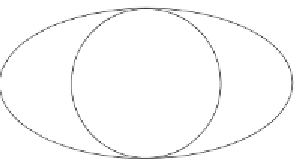Geology Reference
In-Depth Information
q
i
a
i
3
c
i
a
i
(1 +
f
i
)
2
1
Figure 5.5 The inner core is tilted at angle θ
i
with respect to the rest of the
Earth. We divide the volume
V
0
outside the inner core into three distinct regions.
Region
is bounded on the inside by the inner core and on the outside by a sphere
with radius equal to the equatorial radius
a
i
of the inner core. The polar radius of
the inner core is
c
i
.Region
➀
lies between region
and the equipotential with
➁
➀
polar radius
a
i
and thus equatorial radius
a
i
(1
+
f
i
), where
f
i
is the flattening of
the inner core. Region
is exterior to region
.
➂
➀
Because
f
i
1/400, our calculations will only be carried out to first order in the
flattening. For the same reason, regions
➀
and
➁
can be treated as surface densities,
using the density just outside the inner core denoted by ρ
i
.
We begin with the evaluations of the contributions of regions
➀
and
➁
to the
gravitational potential
V
0
. For region
➀
, entirely within the sphere of radius
a
i
,we
can use the expansion (5.117) for
1
1
D
.
r
|
=
(5.221)
|
r
−
For region
➁
, entirely outside the sphere of radius
a
i
, the expansion (5.118) can
be used. Since the mass distribution in region
➀
is symmetrical with respect to the
rotated inner core, no contribution to the restoring torque results, and we focus on
the contribution of region
➁
to the gravitational potential
V
0
. This contribution is
G
G
ρ
i
r
r
n
∞
ρ(
r
)
1
r
V
≈−
V
.
−
d
P
n
(cos
Θ
)
d
(5.222)
|
r
−
r
|
➁
➁
n
=
0
The equipotential forming the outer boundary of region
➁
, with polar radius
a
i
,has
mean radius
a
i
=
(1
+
2
f
i
/3). The equipotential surface then is given by















Search WWH ::

Custom Search